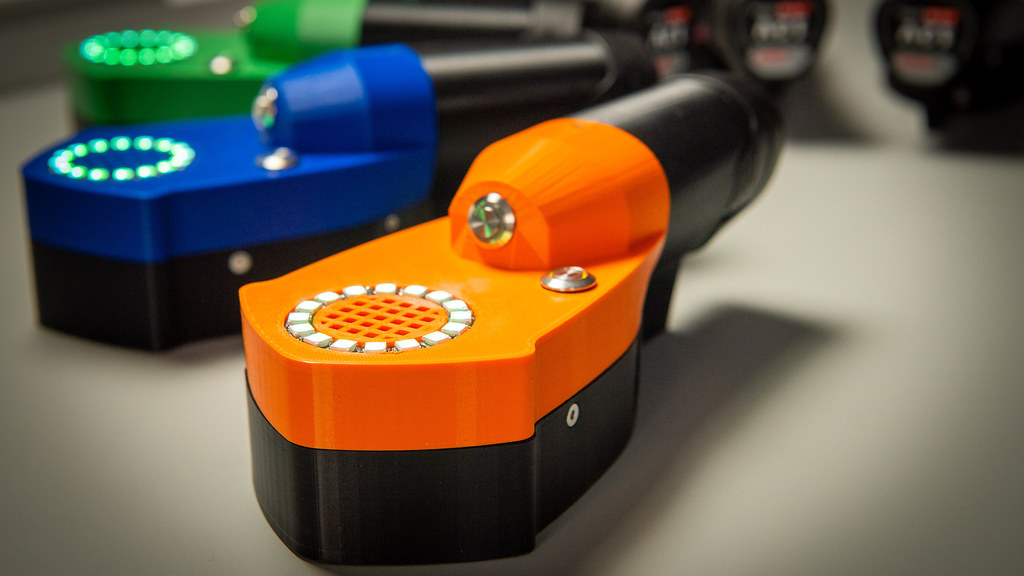A device that lights up in the presence of illegal drugs soaked into paper or fabric is expected to be cleared for rollout across the UK over the next few months.
The pocket-sized device, invented by scientists at the University of Bath has been developed with funding from the UK government's Defence and Security Accelerator (DASA) fund.
The device is intended to detect the synthetic cannabinoid Spice – a class of psychoactive substances used predominantly in prisons and homeless communities in the UK. The drug can be fatal and often causes severe side effects, including psychosis, stroke and seizures.
The researchers hope that in its current format, the drug detector will be used to stem the flow of Spice smuggled into prisons and reduce the devastating effects on users of these highly addictive synthetic drugs. With further engineering, they are confident their device will be able to detect all types of synthetic drugs.
Professor Christopher Pudney, who led the research from the Department of Life Sciences at Bath, said: “Our device is truly ground-breaking – it’s battery-operated, ultra-portable, low-cost and gives instant results that anyone can interpret.
“Detecting Spice is a major challenge with currently available technology, not least because the substance is usually smuggled into prisons absorbed into physical products like paper and fabric, and now also in vape liquid, which makes detection very difficult.”
The device, and it’s potential to revolutionise the detection of Spice, is described this week in the journal Analytical Chemistry.
National rollout
The researchers expect that the new tool – designed to light up in the presence of synthetic drugs – will be ready for mass production this Autumn. The team is currently looking for a company able to manufacture the device at scale and distribute it to prisons, probation services, homeless shelters and relevant charities – initially in the UK but eventually also overseas.
Spice can be soaked into paper or other solid materials like clothing, and this has become a common way to smuggle it into institutions, as most detection technologies struggle to produce a reliable result when testing 'complex' materials.
Professor Pudney said: “Typically, Spice enters prisons on paper, and once it’s inside, it’s divided into smaller paper sheets in the prison and then sold. The paper is crumpled up and inserted into a vape pen and smoked, so detection in the prison environment is incredibly challenging.”
The device is unique, being able to detect drugs on a very broad range of different materials and with high accuracy (95%). The team has even shown detection in vape liquid and the caps of vape pens.
“We see our device being used to decrease the amount of Spice used by all vulnerable communities, and we hope that leads to a better chance for people to recover from addiction and decrease serious health outcomes,” said Professor Pudney.

Chris Pudney demonstrates how a ring of LEDs lights up when the device detects Spice
Instant detection
The device works by detecting the fluorescent properties that make up the core part of the synthetic cannabinoid molecule.
When the device touches a material that is suspected to contain absorbed Spice, it first identifies the material it’s on and then tests for the presence of Spice. An ‘alarm’ for Spice shows up as a glowing ring of LEDs, visible to the operator to alert them to the presence of the substance. The greater the concentration of Spice, the brighter the LEDs glow.
Professor Pudney’s team is now working on modifying the device to detect all synthetic drugs, including highly addictive benzodiazepines and opioids. They believe this objective may be achieved within the next two years.
Much more dangerous and unpredictable than cannabis
Spice was originally designed to mimic the effects of natural cannabis, but it is much stronger than cannabis, making it considerably more dangerous and unpredictable.
Recently, Spice has also been added to liquids in vapes, putting unsuspecting smokers at risk.
Generally, smokers are duped into smoking Spice when they have bought their vape liquid from a dealer and believe they are smoking vape liquid containing THC (one of the psychoactive substances extracted from cannabis) or cannabis oil. Even when hidden this way, however, the drug can be easily detected by the new device.
“We can spot Spice easily simply by opening a vape and testing the mouth filter,” said Professor Pudney.
Professor Stephen Husbands and Dr Gyles Cozier, also from the Department of Life Sciences at Bath, are also involved in this research.

